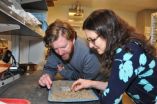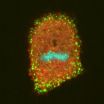(Press-News.org) Teenage boys who show a combination of depressive symptoms and elevated levels of the 'stress hormone' cortisol are up to fourteen times more likely to develop major depression than those who show neither trait, according to research funded by the Wellcome Trust.
In a study published today in the Proceedings of the National Academy of Sciences, researchers from the University of Cambridge have identified the first biomarker – a biological signpost – for major, or clinical, depression. They argue that this could help identify those boys in particular at greatest risk of developing the illness and provide treatment at an earlier stage.
Major, or clinical, depression is a debilitating mental health problem that will affect one in six people at some point in their lives. However, until now there have been no biomarkers for major depression; this is believed to be, in part, because both the causes and the symptoms can be so varied.
"Depression is a terrible illness that will affect as many as ten million people in the UK at some point in their lives," says Professor Ian Goodyer from the University of Cambridge, who led the study. "Through our research, we now have a very real way of identifying those teenage boys most likely to develop clinical depression. This will help us strategically target preventions and interventions at these individuals and hopefully help reduce their risk of serious episodes of depression and their consequences in adult life."
Dr Matthew Owens from the University of Cambridge, first author on the study, adds: "This new biomarker suggests that we may be able to offer a more personalised approach to tackling boys at risk for depression. This could be a much needed way of reducing the number of people suffering from depression, and in particular stemming a risk at a time when there has been an increasing rate of suicide amongst teenage boys and young men."
The researchers measured levels of cortisol in saliva from two separate large cohorts of teenagers. The first cohort consisted of 660 teenagers, who provided four early morning samples on schooldays within a week and then again twelve months later. The researchers were able to show within this cohort that cortisol levels were stable over one year in the population at large in both boys and girls.
A second cohort, consisting of 1,198 teenagers, provided early morning samples over three school days.
Using self-reports about current symptoms of depression collected longitudinally over the twelve months and combining these with the cortisol findings, Professor Goodyer and colleagues were able to divide the teenagers in the first cohort into four distinct sub-groups, ranging from those with normal levels of morning cortisol and low symptoms of depression over time (Group 1) through to those teenagers with elevated levels of morning cortisol and high symptoms of depression over time (Group 4) – this latter group made up one in six (17%) of all subjects. Importantly, the research group replicated exactly these sub groups using the second cohort.
Because the two cohorts gave identical results, Professor Goodyer and colleagues were able to combine them and study the whole sample of 1,858 teenagers for the probability of developing clinical major depression and other psychiatric disorders when followed up 12 to 36 months later.
The subjects in Group 4 were on average seven times more likely than those in Group 1, and two to three times more likely than in the other two groups, to develop clinical depression. Further analysis revealed that boys in Group 4 were fourteen times more likely to suffer from major depression than those in Group 1 and two to four times more likely to develop the condition than either of the other two groups. Girls in Group 4, on the other the other hand, were only four times more likely than those in Group 1 to develop major depression, but were no more likely to develop the condition than those with either elevated morning cortisol or symptoms of depression alone. The findings suggest gender differences in how depression develops.
In order to demonstrate that the combination of high levels of cortisol and depressive symptoms was indeed a biomarker for a particular type of depression, the researchers needed to show that the teenagers in Group 4 were different from those in the other groups. They demonstrated this using a memory test completed on the first cohort consisting of systematically recording episodes recollected from an individual's life (known as 'autobiographical memory') under standardized test conditions.
Both boys and girls in Group 4 were particularly poor at systematically recollecting specific autobiographical memories from over thirty example situations across different social and personal domains. For example, when given the word 'picnic', most teenagers give a fairly detailed account of a time when they went on a picnic and who they were with; in Group 4, individuals tended to give very little, and more general non specific, information. This supports evidence from the scientific literature that suggests that high cortisol acts to suppress autobiographical memory recall.
The researchers hope that having an easily measurable biomarker – in this case, elevated cortisol plus depressive symptoms – will enable primary care services to identify boys at high risk and consider new public mental health strategies for this subgroup in the community.
The research has been welcomed by the Wellcome Trust, which funded the study. Dr John Williams, Head of Neuroscience and Mental Health, says: "Progress in identifying biological markers for depression has been frustratingly slow, but now we finally have a biomarker for clinical depression. The approach taken by Professor Goodyer's team may yet yield further biomarkers. It also gives tantalising clues about the gender differences in the causes and onset of depression."
INFORMATION: END
First biological marker for major depression could enable better diagnosis and treatment
2014-02-18
ELSE PRESS RELEASES FROM THIS DATE:
Why tackling appetite could hold the key to preventing childhood obesity
2014-02-18
A heartier appetite is linked to more rapid infant growth and to genetic predisposition to obesity, according to two papers published in JAMA Pediatrics today (Monday).
The studies investigated how weight gain is linked to two key aspects of appetite, namely lower satiety responsiveness (a reduced urge to eat in response to internal 'fullness' signals) and higher food responsiveness (an increased urge to eat in response to the sight or smell of nice food).
The first paper reveals that infants with a heartier appetite grew more rapidly up to age 15 months, potentially ...
Ancient herring catch nets fisheries weakness
2014-02-18
Archaeological data indicate modern herring management needs to take a longer look into the past to manage fisheries for the future says a new study involving Simon Fraser University researchers.
That is one of the key findings in the study, just published online in Proceedings of the National Academy of Sciences (PNAS). SFU researchers Iain McKechnie, Dana Lepofsky and Ken Lertzman, and scientists in Ontario, Alberta and the United States are its co-authors.
The study is one of many initiatives of the SFU-based Herring School, a group of researchers that investigates ...
'It takes a village' -- Community-based methods for improving maternal and newborn health
2014-02-18
A series of studies are published in a special supplement that presents results of the Maternal and Newborn Health in Ethiopia Partnership—a three-year pilot program funded by the Bill & Melinda Gates Foundation with the goal of improving the health of Ethiopian mothers and their newborns. This special issue of the Journal of Midwifery & Women's Health is published by Wiley on behalf of the American College of Nurse-Midwives.
High mortality rates for pregnant women and newborns continue to be a major health concern in Africa, with Ethiopia being one of the most affected ...
Mitosis mystery solved as role of key protein is confirmed
2014-02-18
Researchers from Warwick Medical School have discovered the key role of a protein in shutting down endocytosis during mitosis, answering a question that has evaded scientists for half a century.
The study, published today in the journal eLife, is the first to outline the role of actin, a protein, in shutting down clathrin-dependent endocytosis during mitosis.
Endocytosis is the process by which cells absorb molecules that are too large to pass through the plasma membrane, such as proteins. Clathrin-dependent endocytosis is the most common route for this. Clathrin, a ...
Learning to see better in life and baseball
2014-02-17
With a little practice on a computer or iPad—25 minutes a day, 4 days a week, for 2 months—our brains can learn to see better, according to a study of University of California, Riverside baseball players reported in the Cell Press journal Current Biology on February 17. The new evidence also shows that a visual training program can sometimes make the difference between winning and losing.
The study is the first, as far as the researchers know, to show that perceptual learning can produce improvements in vision in normally seeing individuals.
"The demonstration that ...
Outsmarting nature during disasters
2014-02-17
The dramatic images of natural disasters in recent years, including hurricanes Katrina and Sandy and the Tohoku, Japan, earthquake and tsunami, show that nature, not the people preparing for hazards, often wins the high-stakes game of chance.
"We're playing a high-stakes game against nature without thinking about what we're doing," geophysicist Seth Stein of Northwestern University said. "We're mostly winging it instead of carefully thinking through the costs and benefits of different strategies. Sometimes we overprepare, and sometimes we underprepare."
Stein will ...
Zoonotic diseases and global viral pandemics
2014-02-17
Emergence of new microbes
While many endemic infectious diseases of humans have been largely contained, new microbes continue to emerge to threaten human and animal health. Such emerging infectious diseases are not confined to humans and their livestock but extend to wildlife ecosystems; the finely-tuned dynamic balance of which is destabilised by human interventions. The changes in the scale and manner of livestock production and marketing, the increase of global travel and trade including the trade in domestic livestock as well as the pet animal trade, the increasing ...
JCI early table of contents for Feb. 17, 2014
2014-02-17
Neurotensin conjugate provides pain relief in animal models
The small peptide neurotensin is a potent regulator of dopamine signaling and can provide dramatic pain relief; however, the blood brain barrier provides a substantial challenge toward clinical use of neurotensin for analgesia. In this issue of the Journal of Clinical Investigation, Philippe Sarret and colleagues at Université de Sherbrooke generated a conjugate of neurotensin with a peptide able to cross the blood brain barrier and evaluated the analgesic effects of this molecule in animal models of pain. The ...
Extensive renewal of the T cell repertoire following autologous stem cell transplant in MS
2014-02-17
WA, Seattle (February 17, 2014) – A new study describes the complexity of the new T cell repertoire following immune-depleting therapy to treat multiple sclerosis, improving our understanding of immune tolerance and clinical outcomes.
In the Immune Tolerance Network's (ITN) HALT-MS study, 24 patients with relapsing, remitting multiple sclerosis received high-dose immunosuppression followed by a transplant of their own stem cells, called an autologous stem cell transplant, to potentially reprogram the immune system so that it stops attacking the brain and spinal cord. ...
Finding common ground fosters understanding of climate change
2014-02-17
EAST LANSING, Mich. — Grasping the concept of climate change and its impact on the environment can be difficult. Establishing common ground and using models, however, can break down barriers and present the concept in an easily understood manner.
In a presentation at this year's meeting of the American Association for the Advancement of Science, Michigan State University systems ecologist and modeler Laura Schmitt-Olabisi shows how system dynamics models effectively communicate the challenges and implications of climate change.
"In order to face the ongoing challenges ...

